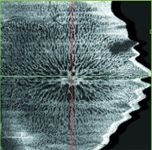Article
Spectral-domain OCT data collection
Spectral-domain optical coherence tomography (OCT) collects data that are extensive and allow software to generate displays that are clinically far superior to the data obtained using time-domain systems, according to one ophthalmologist.

Key Points

Dr. Friberg, professor of ophthalmology and bioengineering at the University of Pittsburgh Medical Center (UPMC) Eye Center, described the reasons he believes spectral OCT will have an impact on retinal imaging and should be taken seriously. Although historically very useful, time-domain OCT systems, he said, had shortcomings-slower scanning speed and a lower sampling density-that are becoming more germane. Also, in many clinical studies in which the ability to measure the thickness of the macula is necessary, Dr. Friberg added, time-domain systems use radial scans centered on the foveola. These scans take 1 to 1.5 seconds or longer to generate a thickness map. Although these images are very useful, the precise registration of images taken serially over time might not be achieved when obtaining images by such a method and may introduce some potential error, he said.
Also, the older technology might introduce errors into the scanning, Dr. Friberg stated.

In contrast to time-domain systems, spectral-domain (also called Fourier-domain) devices are much faster and perform hundreds of scans over a user-defined region during the same time interval, Dr. Friberg said. The result is a more robust and accurate data set that can be analyzed further, he added. In addition, spectral-domain units achieve a better axial resolution (3 to 5 µm versus 8 to 10 µm) so that the scans typically look much more detailed.
Data acquired using spectral systems can be analyzed and manipulated to display three-dimensional renditions of the retinal tissue and the vitreoretinal interface, Dr. Friberg said. "These features can have substantial clinical relevance," he stated.
Dr. Friberg also showed novel software (C mode) developed at the UPMC Eye Center that has the capability of displaying a thin, three-dimensional section through a specific lamina of the retina and choroid. Using retinal edema as an example, he demonstrated that the outer plexiform layer can be displayed as a single sheet so that the size and density of the cysts within the plexiform layer can be viewed easily in three dimensions. He also showed examples in which pathology that could not be seen clinically on retinal examination was able to be detected. In some cases where the pathology was invisible with time-domain systems, C mode technology could detect the pathology.
Dr. Friberg concluded, "The great advantages of spectral OCT are based not so much on better resolution but on the fact that the data collected are extensive and allow software to generate displays that are clinically far superior to time-domain systems. The differences in software between the different manufacturers of spectral OCT units are much more important than the actual differences in the hardware."





